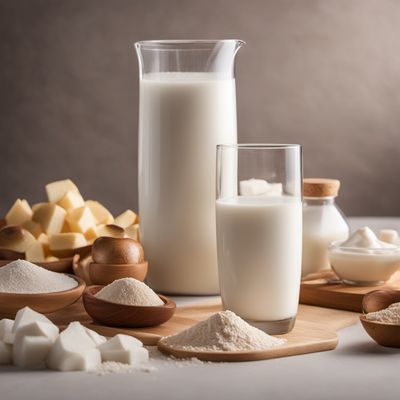
Ingredient
Whey protein
The Powerhouse of Protein: Whey Protein
Whey protein is a byproduct of cheese production and is derived from milk. It is a complete protein, meaning it contains all essential amino acids necessary for muscle growth and repair. Whey protein is available in various forms, including powder and liquid, and has a mild, slightly creamy taste and a smooth texture when mixed with liquids.
Origins and history
The use of whey protein dates back to ancient Greece, where it was consumed for its health benefits. Over the years, whey protein has gained popularity in the fitness and bodybuilding communities due to its ability to support muscle growth and recovery. Today, whey protein is widely recognized as a convenient and effective dietary supplement for individuals with increased protein needs.
Nutritional information
Whey protein is a nutritional powerhouse, providing a concentrated source of protein along with essential amino acids. It is low in fat and carbohydrates, making it an excellent choice for individuals following a high-protein or low-carbohydrate diet. Additionally, whey protein contains bioactive peptides that have been shown to have potential health benefits, such as supporting immune function and promoting muscle recovery.
Allergens
Whey protein is derived from milk and may not be suitable for individuals with lactose intolerance or milk allergies. It is important to read the label and choose whey protein products that are lactose-free or made from alternative protein sources, such as plant-based proteins, for those with dietary restrictions or allergies.
How to select
When selecting whey protein, look for reputable brands that undergo rigorous quality testing and use high-quality ingredients. Choose products that are free from artificial additives, sweeteners, and fillers. Consider the protein content per serving and opt for whey protein isolate or concentrate based on personal preferences and dietary goals.
Storage recommendations
To maintain the freshness and quality of whey protein powder, store it in a cool, dry place away from direct sunlight. Ensure the container is tightly sealed to prevent moisture or air exposure, which can affect the protein's integrity. Liquid whey protein should be refrigerated and consumed within the recommended timeframe stated on the packaging.
How to produce
Whey protein can be produced by separating the whey from milk during the cheese-making process. This liquid whey is then processed to remove the water, lactose, and other components, leaving behind a concentrated protein powder. The powder can be further processed to create different forms, such as whey protein isolate or concentrate.
Preparation tips
Whey protein powder can be easily incorporated into various recipes and beverages. It can be added to smoothies, shakes, or yogurt for a protein boost. Whey protein powder can also be used as a substitute for flour in baking recipes or added to oatmeal, pancakes, or energy bars for added protein content. Experiment with different flavors and combinations to find your preferred way of enjoying whey protein.
Culinary uses
Whey protein is widely used in the fitness and sports nutrition industry. It is commonly used to support muscle growth and recovery, enhance athletic performance, and meet increased protein needs. Whey protein powder is a staple in protein shakes, protein bars, and protein-packed snacks. It is also used in the formulation of meal replacement products and dietary supplements.
Availability
Whey protein is available worldwide and can be found in most grocery stores, health food stores, and online retailers. It is commonly produced in countries with a strong dairy industry, such as the United States, New Zealand, and Denmark.





